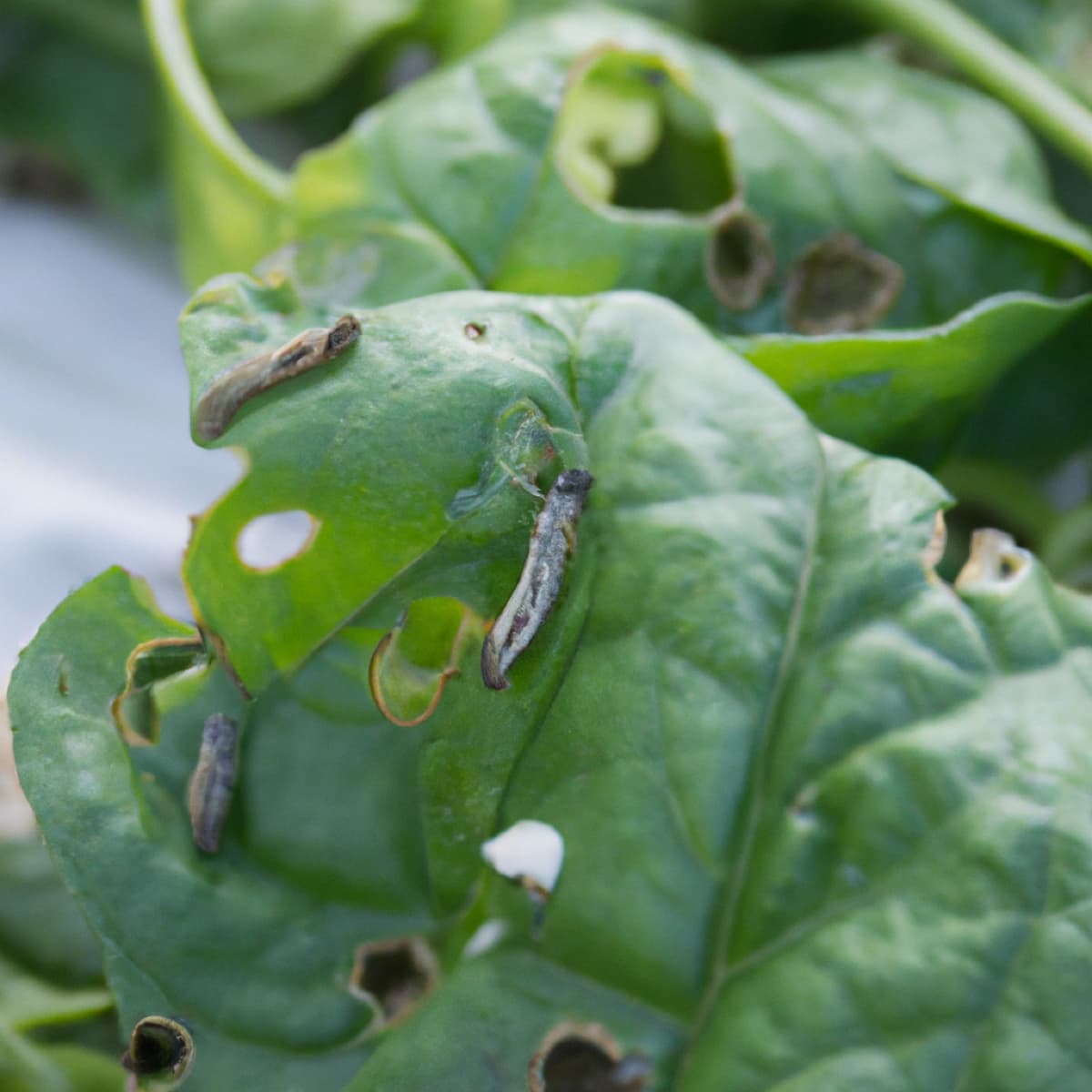The Beet armyworm (Spodoptera exigua) is an important pest of many crops, including spinach. The larvae of this pest feed on foliage, often causing severe damage that can reduce crop yield and quality. This pest is found in many parts of the world and can cause significant economic losses to farmers.

Management of Beet Armyworm in Spinach
The Life Cycle of Beet Armyworm
Egg: Eggs are laid in clusters of 50 to 150 eggs per mass, usually on the lower surface of leaves near blossoms and the tip of the branch. They are greenish to white, covered with a layer of whitish scales that give the egg mass a fuzzy or cottony appearance. Eggs hatch in 2-3 days during warm weather.
Larva: The larval stage of this insect typically goes through five instars, although there may be more. During the first two instars, the larvae are usually pale green or yellow, but in the third instar, they develop pale stripes. By the fifth instar, the larvae have a varied appearance, often green on their back with pink or yellow on their underside and a white stripe along their sides. They may have dark spots or dashes along their back and sides. The larvae have smooth bodies and lack hairs and spines.
Pupa: Pupation occurs in the soil. The chamber is constructed from sand and soil particles held together with an oral secretion that hardens when it dries. The pupa is light brown and measures about 15 to 20 mm long. The pupal period lasts 6-7 days during warm weather.
Adult: The moths are moderately sized, with a 25 to 30-mm wingspan. The forewings are mottled gray and brown, normally with an irregular banding pattern and a light-colored bean-shaped spot. The hind wings are a more uniform gray or white, trimmed with a dark line at the margin. Moths usually live for 9-10 days.
Damage Symptoms of Beet Armyworm in Spinach field
- Skeletonization of foliage: Young Beet Armyworm larvae feed gregariously and skeletonize foliage, leaving behind only the veins and stems. This results in a lace-like appearance of the foliage.
- Irregular holes in foliage: As the larvae mature, they become solitary and eat large irregular holes. This can cause significant damage to the spinach leaves and reduce the yield of the crop.
- Burrowing into the crown: Beet Armyworms may burrow into the crown or center of the spinach plant, causing damage to the growing point. This can result in stunted growth and reduced yield.
- Feeding on buds: In addition to feeding on the foliage, Beet Armyworms may also feed on the buds of the spinach plant, causing damage to the developing leaves and reducing the overall quality of the crop.
Management of Beet Armyworm in Spinach by Cultural Method
- Disk fields immediately following harvest: After harvesting spinach, it is recommended to disk the fields immediately. This helps to kill any remaining larvae or pupae in the field. Destroying the habitat of Beet Armyworms reduces their population and limits their ability to infest the next crop.
- Destroy weeds along field borders: Beet Armyworms often migrate into newly planted fields from weed-infested areas. Therefore, it is important to destroy any weeds along the field borders. This helps to reduce the number of Beet Armyworms in the field and prevent them from infesting the spinach crop.
In case you missed it: Management of Aphids in Spinach: Symptoms, Treatment, Chemical, Biological, Natural, and Organic Control

Management of Beet Armyworm in Spinach by Biological Method
- The Parasitoids Telenomus remus, and Trichogramma spp. are parasitoids that lay their eggs inside the eggs of Beet Armyworms. The parasitoid eggs hatch and consume the Beet Armyworm eggs, thus reducing their population. These parasitoids can be introduced into spinach fields as a biological control agent.
- The Predators are pentatomid bugs, earwigs, red ants, spiders, reduviid bugs, wasps, Bracon spp., Chelonus spp., etc., and are natural enemies of Beet Armyworms. They can be attracted to the fields by providing suitable habitats like hedgerows, flowering plants, and cover crops. These predators feed on Beet Armyworm larvae and pupae, thus reducing their population.
Management of Beet Armyworm in Spinach by Chemical Method
- It is important to note that chemical insecticides should be a last resort and only used if other control methods have failed or are insufficient.
- Sevin Insect Killer contains the pyrethroid insecticide carbaryl. This chemical can effectively control beet armyworms if applied correctly and at the appropriate time.
Management of Beet Armyworm in Spinach by Organic/Natural Method
- Botanical insecticides: Neem, lemongrass, and ginger are natural insecticides that can be used to control Beet Armyworms. The active ingredients in these plants disrupt the life cycle of the Beet Armyworms and can be applied as a foliar spray.
- Essential oils: Essential oils like peppermint, rosemary, and thyme can also control Beet Armyworms. These oils disrupt the feeding behavior and development of the larvae, leading to their death.
- Cottonseed oil: The foliar application of 5% cottonseed oil can control both eggs and young larvae of Beet Armyworms. The oil disrupts the respiratory system of the pests and causes their death.
Preventive Measures for Control of Beet Armyworm in Spinach field
- Plant-resistant species with harder leaf tissues.
- Adjust the sowing time to avoid peak populations.
- Regularly monitor the plants for signs of the pest, especially in the late evening or early morning.
- Use pheromone traps to monitor infestations and identify the best time for pest management.
- Remove weeds and litter in and around the fields as they offer shelter and sites for breeding.
- Practice crop rotation to disrupt the pest’s life cycle and reduce the buildup of pest populations.
- Maintain good field hygiene and sanitation, such as removing plant debris and maintaining proper irrigation and drainage.
- Use natural enemies such as parasitoids and predators to control pest populations.
- Consider using organic or natural pest control methods, such as botanical insecticides or crop rotation with cover crops.
In case you missed it: Management of Leaf Eating Caterpillar in Spinach: Symptoms, Treatment, Chemical, Biological, Natural, and Organic Control

Conclusion
Effective management of beet armyworm in spinach requires a combination of preventive measures, biological control, and, in some cases, chemical control. Planting resistant cultivars, adjusting sowing time, and maintaining good field hygiene can help prevent or reduce infestations.
Biological control methods such as parasitoids and predators can help keep pest populations in check. In cases of severe infestations, natural and organic insecticides can be used. Chemical control with pyrethroids, such as Sevin, should be used as a last resort due to the potential harm to beneficial insects and the development of resistance.
- Beneficial Insects in Pest Management
- Natural Solutions for Pest Control in Flower Gardens
- Types of Fungicides Used in Agriculture
- Common Issues in the Fruit Development Stage of Pomegranate Farming
- Fruit Development Issues in Papaya: Easy Solutions and Treatment
- Soil-Borne Diseases and How to Protect Your Plants
- Practices to Prevent Disease Spread in the Garden
- From Wilted to Thriving: How to Treat Root Rot Naturally in Houseplants
- Natural Remedies to Cure Brown Spots on Fig Tree Leaves